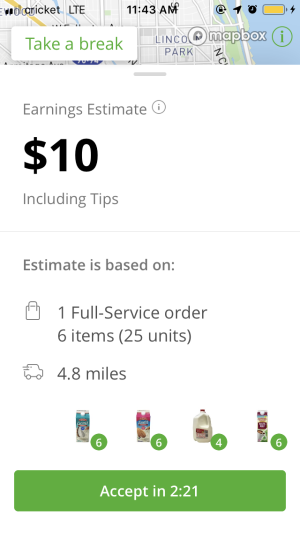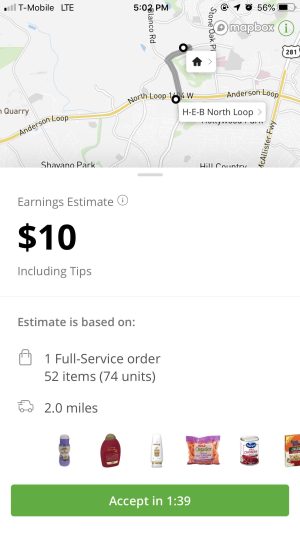Earlier this month, Instacart publicly announced that it had redesigned its «shopper experience for more choice and clarity,» adding that it aimed to «provide clearer and more consistent earnings.»
The San Francisco-based startup, which has more than doubled its total venture capital funding amount in a year to $1.6 billion, allows customers to buy groceries online, which according to the company are marked up for 30 percent of partner retailers. «Shoppers,» in company parlance, are the ones doing the bulk of the labor—they constitute 70,000 workers across North America. The ratio of shoppers to bona fide employees is over 116 to 1.
Shoppers drive to the store, select the items, bag them, and deliver them. Sometimes they even correspond via app with the customer while shopping.
This new pay setup for shoppers (known internally as the «Boulder model,» after the Colorado city where it was pioneered) has already been rolled out in some cities. It will reach all parts of the country by year’s end.
But numerous Instacart workers that spoke with Ars are not happy. They say that their take-home pay has fallen again, this time by an estimated 25-50 percent in some cases. An anonymously-written Medium post calls the new structure «purposefully confusing and unpredictable.»
Many see it as a continued devaluation of the labor that provides the backbone of Instacart. The guaranteed $15 hourly wage that some veteran shoppers were paid when they were hired just a few years ago has all-but disappeared.
«It’s kind of disheartening, as Instacart grows as a company that can compete with Amazon, it’s disheartening that they’re getting bigger and bigger and there’s no trickle down,» William Freeland, a shopper in Sacramento, California, told Ars. He said his pay has been cut in half under the new system, from around $25 per hour to about $12 per hour, before expenses.
«We’ve been getting our pay cut and cut and cut,» he added. «As the company grows, we should be profiting as well.»
Meanwhile, benefits for the company’s nearly 600 employees include «daily meals and snacks,» «take what you need vacation (and we really mean it),» «16 weeks maternity leave and eight weeks paternity leave so you can truly bond with your child,» and more.

Instacart now says that the new system provides far better clarity for shoppers, showing them ahead of time a preview of what they’re agreeing to do and precisely how they’re being paid for it.
«Exact dollar per batch—that’s transparency,» David Hahn, the company’s chief product officer, told Ars in a lengthy phone interview last week.
Hahn joined the company in April 2018 and said that he himself regularly works as a shopper to get a better understanding of what they go through.
«It’s designed to keep average earnings the same, and this is all communicated before the shopper clicks the accept button,» he added.
But does it? Without a systematic study it’s hard to say for certain. Dozens of unhappy shoppers on a closed Facebook group to which Ars was invited say that the change hasn’t been positive.
The startup has been sued multiple times in recent years over what some workers say are notably inadequate wages. Instacart has agreed to pay at least several million dollars to settle the lawsuits, which will result in a typical settlement payout of a few hundred dollars per worker. The attorneys who brought the lawsuits, by contrast, stand to make millions. No new federal lawsuits have been brought this year.
Batch processing
Prior to the Boulder model, it would be complicated for shoppers to figure out how much they were going to take home.
There’s the «commission,» or amount paid out per delivery, which can vary both by time and place, ranging from $1 to $14. On top of that, there are per-item fees (usually around $0.40 per item). Finally, there’s the service fee, which initially did not go to shoppers, and optional tip. A year ago, some workers that Ars spoke with complained that many customers were not tipping in favor of leaving the default «service fee,» which turned out to be optional anyway. Instacart later clarified the in-app wording around the service fee.
But veterans understood how the system worked and always tried to maximize their earnings. Some even would tell customers in-person to remove the service fee and suggest they adjust their tip accordingly.
As the Medium post argued:
The new pay structure is particularly damaging to those who have been loyal to Instacart and rely on it to make a living. There is no longer a base payment per order—simply, the worker is presented with the general details of an order (a summary of items, distance to the customer, and estimated pay) and given the option to confirm or decline. An order that will take an hour and might have paid a worker a minimum of $10 before tip could now offer as low as $3—or even less—after tip. And that’s before even mentioning the fact that workers bring their own cars and pay for their own gas and insurance. In many cases, workers will be losing money to accept orders.
On top of it all, there are hazards that many shoppers face when being given exceptionally bulky or heavy items—cases of water, for instance—and don’t have adequate vehicle space, physical strength, or other equipment (a dolly) that would otherwise be needed to handle such items.
Instacart headquarters in San Francisco encourages shoppers to flag orders that stand out in some way, but shoppers say that this doesn’t always work in practice.
So how do shoppers now get paid under the Boulder model?
They are shown a holistic «earnings estimate» with a preview of the specific items requested, a travel distance, and any relevant «Peak Boost.» Shoppers can accept the job or decline it.
But after declining just four jobs, according to Instacart spokeswoman Kelly Pakula, shoppers won’t be able to accept new batches as the app assumes that they are idle. Shoppers are immediately logged out, and there is a 30 minute window during which they can sign back on, but if not, then they are done for the day. (A «batch,» in Instacart argot, means entering a store on behalf of one or as many as three customers and their corresponding orders.)
But numerous shoppers though, told Ars that in actuality, shoppers are largely unaware of this half-hour timeframe.
In any case, shoppers are then paid out in a «Batch Payment,» a «Batch Incentive,» mileage reimbursement at $0.60 per mile (above the current federal standard at $0.545 per mile), and a tip.

«It’s not just equipment and physical strength; it’s also time expended on those bulky items which costs us the time that could be expended on other orders,» Vanessa Bain, a shopper in Menlo Park, California, who sometimes also works in Sacramento, which has the new pay structure already. «We used to have incentives to fulfill those orders, and they’ve taken them out. They’ve claimed that this new structure takes into account, but they’ve provided no evidence to that. They’re not being transparent. Every time they say that this is going to benefit you, it completely and totally screws us.»
Or put another way: «There’s no reason your labor should cost more on a Monday to deliver a case of water than on a Tuesday. There’s no other jobs that I know of that work that way.»
Last Wednesday, a shopper in Atlanta who wished to remain anonymous for fear of retribution sent Ars an example of an order he received earlier that day.
«I got stuck with this one today!» he wrote. «It popped up 30 seconds before the 9:00am rush for hours so I had no choice but to accept it or I wouldn’t have been able to work next week.»
The estimate listed a «full-service order» for «five items (14 units)» at a distance of over three miles away. The previewed items include an assortment of groceries, including 10 cases total of three different types of bottled water.
In the end, the shopper did the job, received a payment of $3.57, an incentive of $1.35, a mileage reimbursement of $2.22, and a $6.43 tip, totaling exactly $10.
Why $10? Since November 5, Instacart has rolled out an earnings minimum of $10 as a way to mitigate people making small amounts of money for large amounts of effort. (Ars spoke with numerous Instacart shoppers who said that they were unaware of this new payout floor.)
When Ars presented this batch screenshot to Instacart, a spokeswoman said that this might be an «edge case.»
«Our new heavy-batch feature rolled out just last week,» Kelly Pakula, a spokeswoman, emailed. «Our engineering team is actively working to ensure our new weight database—which includes tens of millions of items—is as accurate and up to date as possible. We’re continuing to adjust for edge cases, such as this, that may not be taken into account under the current algorithm.»
We spoke with another shopper in Denver who was also granted anonymity. He was offered $15.83 to deliver 45 cases of water from a Sam’s Club that was seven miles away.
«Definitely not worth the backache or wear and tear on vehicle,» he wrote. «Hard no!»
When asked what this same order would have paid out under the old system, he responded:
Minimum would’ve been maybe around $25 with distance, not including tip. These orders usually don’t tip. Also we were able to call about these bigger orders and get «shopper bumps» for the size. In my experience, I would usually get a minimum of $15 extra for these type of orders on top of the $25.








